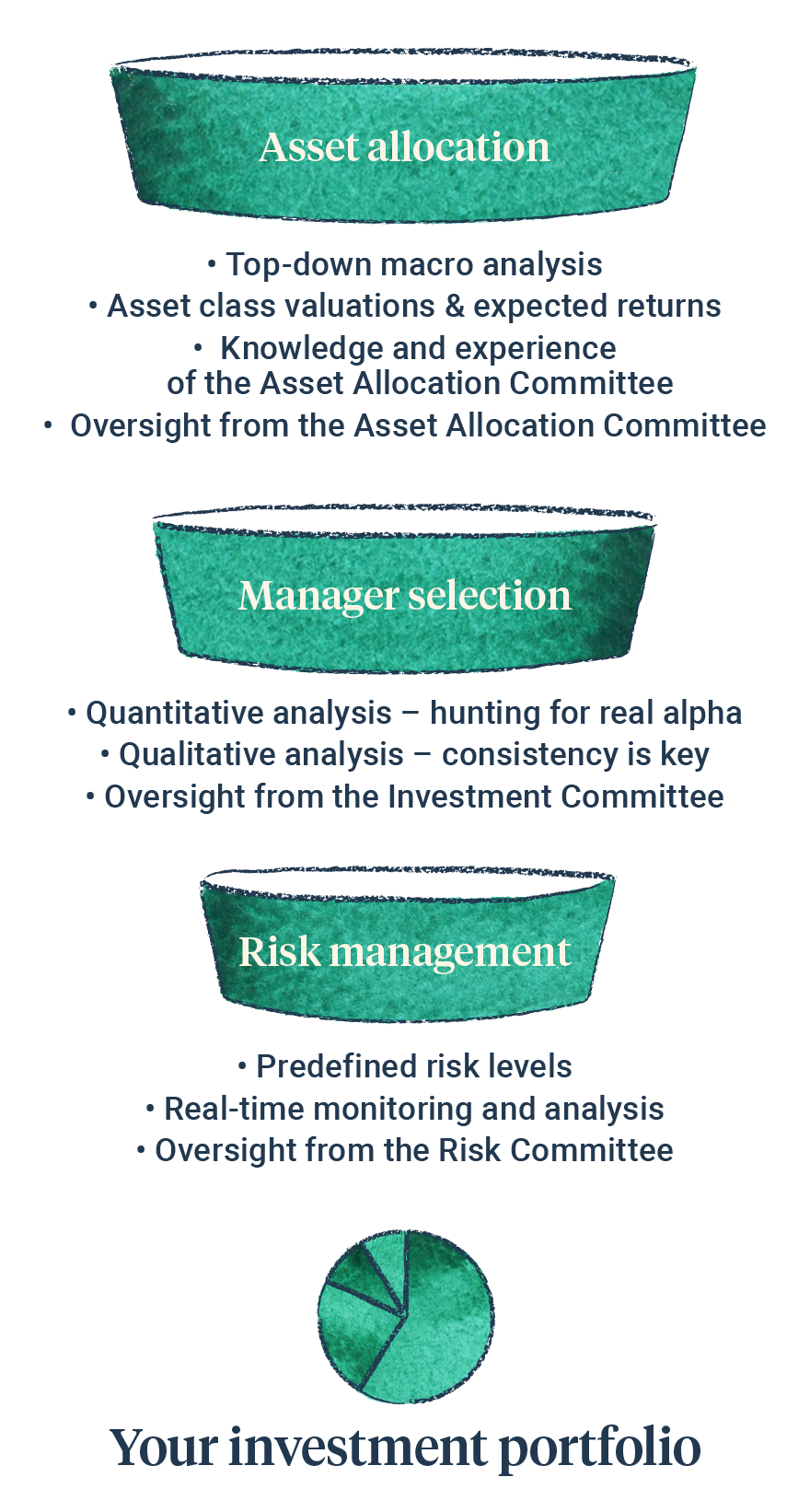
Investment conditions

Growth (economic)
Once again, the global economy has demonstrated its resilience, although a slight negative shift in momentum has become evident. Recent trends in leading indicators have signalled a gradual cooling of the economy. Headline inflation has cooled but remains elevated, influencing central bank policy and financial markets.
The strongly positive impulse from China reopening has diminished, financial conditions are tighter due to higher interest rates and a reduction in lending. Labour markets have weakened, with increases in the number of jobless claims and a fall in job openings, hiring plans and overtime.
Unemployment remains at or near to historic lows in the Eurozone (6.4%), UK (4.2%) and US (3.5%). The UK’s unemployment rate recently increased by 0.3% but is still at half its peak post the 2008 Financial Crisis. Wage growth is robust, with the period from April to June exhibiting the most substantial regular annual growth rates observed since 2001, standing at an impressive 7.8%.
Looking ahead, the IMF expects global growth to fall from an estimated 3.5% in 2022 to 3% in both 2023 and 2024.
Interest rate & liquidity environment
Most major economies continue to raise interest rates in an attempt to cool inflation, central bank rates are now above 5% in the UK and US but were recently reduced in China. Monetary policy remains tight, increasing the risk of a policy mistake in our view. Liquidity conditions had turned mildly positive in aggregate, but their durability was always in question and recent data show liquidity growth stalling.
Valuations & earnings outlook
Corporate earnings in the United States have been flat over the past year, and profit margins remain adequate on aggregate.
The technology sector encountered demanding expectations; however, many companies have continued to produce results that have surpassed initial predictions. Sectors beyond technology that thrive in the resurgence of economic activity broadly have outperformed initial predictions, but there has been a pick-up in insolvencies in some sectors. Positive performance is notably observed in industrials, communication services, and consumer discretionary sectors.
Comparatively, the second-quarter earnings of European companies faced a more significant contraction, twice that of their US counterparts. This contraction has contributed to European stocks exhibiting weaker performance in comparison to their counterparts in developed markets.
Assessing the value of different asset classes compared to historical patterns indicate that investors are now pricing in a lower probability of recession than they did earlier this year. However, many assets are still trading significantly more cheaply than others, for example smaller company stocks (especially the UK and mainland Europe), as well as many emerging and frontier markets.
Sentiment / flows
Stock market momentum recently picked up, and stock volatility remains low. Bond market volatility remains high due to uncertainties in central bank policy. Easing inflation numbers coupled with robust GDP growth have boosted confidence.
Views by asset class

Equities
In the bigger picture, the world of equities is showing some positive signs, including a broadening of the rally from mega cap technology stocks to smaller, more economically sensitive companies. We remain more cautiously positioned than we could be, mindful of the uncertain economic environment. We decided to keep our overall exposure in equities unchanged, but we made some regional changes as described below.
We had recently decided to increase exposure to Asia, emerging markets, and frontier markets (see the Manager In Focus Section for more information). This decision contributed meaningfully to investment portfolios. Many of these countries are ahead of developed markets when it comes to growth and recovery, they haven’t had the same cost increases as some Western countries and have been trading more cheaply than many developed markets.
Among the developed markets, we express a preference for Japanese equities, given the ongoing accommodative policy, presence of negative real interest rates, and the implementation of shareholder-friendly reforms that are taking hold. We decided to increase our exposure to Japan, which is a theme that has worked well for portfolios.
In a previous asset allocation cycle, the committee decided to increase our exposure to larger cap growth stocks in the US, which went on to outperform. We decided to maintain our exposure to this area.
We have for some time been tilting portfolios towards both the “value” and “income” styles. Some of this exposure is picked up by global companies listed on UK stock markets, but who derive most of their revenues outside of the UK. The committee decided to maintain this style of investing, and our exposure to those companies listed in the UK. We continue to have significantly less exposure to the UK economy than most of our peers.
We remain unconvinced about the case for European equities, given uncertainties over many factors in the region, such as weakness in Germany. Because of the uncertainties, we reduced our exposure to European stocks, but maintained our exposure to our long/short equity manager because they can generate returns from both rising and falling stock prices.
Overall, we continue to tilt our equities towards quality companies (those typically more resilient when the outlook deteriorates), value companies (which are cheaper than the average stock so have a greater margin of safety in the price), and smaller companies (which are trading more cheaply than the average stock).
Government bonds
Having avoided most of the drawdowns in government bonds last year, through 2022 the asset allocation committee had been investing in the asset class, attracted by the higher yields on offer and the protection from the US dollar (until we hedged much of the dollar exposure late in the year). Last year, traditional UK government bonds suffered significant falls (we didn’t own any), but they now offer positive returns above expected inflation for the first time in many years, and we have been increasing our exposure to short-dated UK government bonds yielding around 5%.
In the most recent meeting, the committee decided to change our exposure to government bonds, reducing exposure to 7 to 10 year US government bonds, increasing exposure to short dated UK gilts and US Treasuries. The committee also decided to increase exposure to long dated US bonds to increase recession protection.
Corporate bonds
The committee felt parts of the bond market are looking complacent, too richly priced given the outlook. The committee voted to reduce our exposure to investment grade bonds and high yielding corporate bonds, which have seen significant positive performance this year.
The committee decided to maintain our exposure to emerging market bonds. These bonds are still trading at noticeable discounts, offering both attractive yields and the possibility of substantial increases in their value. Additionally, emerging market bonds should gain from a weaker US dollar, which contrasts with other parts of our portfolio that would benefit from a stronger dollar.
Alternatives
Alternative asset classes can provide protection during market falls, with returns not correlated to the rest of the portfolio. For this reason, we are still positive on this asset class.
We have positions in broad commodities as well as copper, all of which look undervalued on a long-term view. We have some macro hedge funds that can add significant value in times of heightened volatility. We also have positions in gold and gold miners; gold can provide meaningful protection when inflation surprises on the upside, and gold miners are significantly undervalued in our view.
Overall, the environment is characterised by high uncertainty about the macro-economic outlook, so we remain cautiously positioned, but prepared to take advantage of opportunities that present themselves.
Summary of positioning

Below is a summary of our views for each asset class, from strongly negative (- -) to strongly positive (+ +).
Asset Class
| Asset class | -- | - | Neutral | + | ++ |
|---|---|---|---|---|---|
| Equities | X | ||||
| Government bonds | X | ||||
| Corporate bonds | X | ||||
| Alternatives | X | ||||
| Cash | X |
Asset Class Breakdown
| -- | - | Neutral | + | ++ | ||
|---|---|---|---|---|---|---|
| Equities | USA | X | ||||
| UK | X | |||||
| Europe | X | |||||
| Japan | X | |||||
| Asia ex-Japan | X | |||||
| Emerging markets | X | |||||
| Bonds | Government | X | ||||
| Index-linked | X | |||||
| Investment grade | X | |||||
| High yield | X | |||||
| Emerging market | X | |||||
| Convertibles | X | |||||
| Structured credit | X | |||||
| Alternatives | Commodities, gold + miners | X | ||||
| Macro hedge + other alts | X |
Investment Committee Q&A

The Committee last met two months ago, what has happened since then?
Equities peaked at the end of July and have since lost a bit of their shine but are still up 15% in the case of the S&P500 US large capitalization index for example. The big moves have been in fixed interest where there has been a big increase in real yields. It is important to remember that in the twelve years after the GFC of 2008/9, both nominal and real interest rates and yields fell to extremely low levels. This rise in real yields has resulted in a sharp selloff in price terms of both conventional bonds and inflation-linked securities. Over the last month, for example, the 20-year conventional gilt yield has risen by 38 basis points (0.38%) and the 10-year US inflation linked real yield has risen recently to 2% from 1.06% in early April. This latter example gives a good indication of the rises in real yields. What all this represents is a normalisation of interest rates after the quite exceptional period of very low interest rates over recent history. Given how many people, governments and financial institutions expected very low interest rates to continue, it is going to take some time for all the implications of higher real yields to become clearer. The other big piece on global news is the confirmation that China has moved into deflation and that the underlying problems in the huge, indebted, domestic property market remain unresolved. China is again exporting tradable good deflation to the rest of the World and, at the margin, is one of the reasons why we continue to believe inflation has peaked.
What has been driving investment markets in this period?
In addition to the big moves in real yields, markets continue to be dominated by assessments of central bank policy, which is itself largely a function of the inflation outlook as it has been through the recent interest rate increase cycle. Equity returns have continued to be driven by quality and ‘growthier’ companies particularly in the technology sector.
What has been working well for our portfolios, and what has been less effective?
There have been no standout trends where it has been easy to identify a consistently winning strategy. That said, our equity holdings have a long-standing bias to quality which continues to serve portfolios well. Much of what has been helpful for us is avoiding the areas of conspicuous weakness like Chinese assets, where we have a long-standing scepticism, as well as infrastructure and real estate, both of which tend to rely heavily on leverage and where prices have been hit hard by the increases in real yields. In lower risk portfolios, we have been slowly adding to duration as interest rates have risen from an extremely low starting position. With hindsight, this has been a bit early and has had a negative impact on returns, but we do believe inflation will fall more than anticipated and at current levels fixed income looks much more attractive than for many years.
Have companies been able to protect their profit margins despite the rise in inflation?
Yes, and this has particularly been a characteristic of larger, ‘quality’ companies with strong balance sheets, barriers to entry and strong management teams. There is a risk to these margins, however, as the accumulated household excess savings of the Covid pandemic period are being drawn down to maintain consumption in the US. We are monitoring this closely.
In the recent asset allocation meeting you described the upwards movement in global stocks as “the most unloved bull market in history” – what did you mean by that?
Yes, it probably is. There has been lots of scepticism about risk assets and I think this is largely a function of the fact that we haven’t had the most anticipated recession in history. Given levels of debt if there had been a ‘proper’ recession associated with Covid and its aftermath, then equities could easily have fallen, as many anticipated, by 30-40% from their peak. Within equities, the leadership of the ten largest ‘mega cap’ US technology companies has also caused much angst among active fund managers as very few, if any, have had full weights relative to indices in these stocks causing stock picker underperformance.
We now have positive real yields for the first time in years (where the cost of borrowing is higher than expected inflation). Is this a threat or an opportunity for investors?
As before, higher real yields are a real problem for investments typically involving leverage like property, infrastructure and private equity. That said, there have been some big falls in prices in these areas already and investors who are able to take advantage of this repricing should be seeking out opportunities to buy good quality investments cheaply from distressed sellers. We are starting to do this very selectively in private assets where some prices already look very attractive.
Is the committee worried about the scale of debt in the US, and the game of cat and mouse its politicians play with the debt ceiling?
Again, yes, and the deterioration in the US government’s fiscal position has been one of the contributors to the recent rise in government bond yields. The concern is not the federal expenditure but rather the conspicuous weakness of receipts at what should be a strong phase of the economic cycle. The other issue exacerbating weakness in government fiscal positions, and this is a real issue in the UK, is the higher costs of debt servicing as interest rates have risen. It isn’t just companies and households that are affected by higher interest rates.
Within the asset allocation meeting reference was made to a “buyers strike” for US government bonds, what does this mean and what are the implications of this?
To be clear, there isn’t a ‘buyers strike’ for US government bonds – at least not yet. If there were, yields would be significantly higher. The relevant other big ‘macro’ contributors to higher bond yields have been the ending of the Bank of Japan yield curve control, which kept interest rates at extremely low levels, which now makes domestic Japanese bonds relatively more attractive and a pattern of much lower purchases of US Treasuries by the Bank of China and the Middle Eastern oil producers. Medium term debt projections for the US are starting to become a real concern given the scale of unfunded entitlements. There could be a real risk of governments ‘crowding out’ borrowing as they compete with the private sector for funding at a time when the sheer scale of the energy transition funding requirements is becoming more pressing. All this said, the US as the controller of the US dollar global reserve and trading system has an extraordinary ability to fund itself internationally. There is a risk to this system, which we are monitoring, but we still believe China will find it impossible to create a parallel reserve and trading system to rival the US any time soon.
The US economy, and its stock market, have been very resilient. What’s behind this? Do you expect this to continue? What could see a reversal?
I have observed before the extraordinary dynamism and resilience of the US economy. It has really been characterised by rolling sector recessions rather than one big economy-wide recession. The US corporate sector has an extraordinary ability to transfer resources from declining and unproductive parts of the economy into productive parts and its capital markets and entrepreneurs have a similarly extraordinary ability to back new ideas and, it should be said, get very handsomely rewarded for success. US stock markets trade expensively relative to the rest of the World, so a lot of value investors find it difficult to invest there. This also is part of the scepticism about the most unloved bull market in history. It has been driven by a small number of companies in the most expensive large equity market. The history of equity investing, though, over longer periods of time is that most excess returns are driven by a small number of stocks that show real innovation and that can capture the commercial returns from that innovation. It is very difficult to see the US losing this dynamism, particularly given that the Federal government is now putting real effort into onshoring supply chains away from China and the energy transition.
We have seen the Pound rallying recently, what’s been behind this, and do you expect it to continue?
It has rallied a bit as there is a more stable and economically literate team in charge of the government in the eyes of international investors and higher interest rate differentials are pound supportive. I wouldn’t get too carried away, however, as the underlying issues of weak growth and particularly productivity growth and the twin deficits in the fiscal and trade positions continue.
If you were talking to a UK based investor looking to preserve their long-term wealth, and weighing up holding cash (at higher interest rates now than in recent history) versus an investment portfolio, what counsel might you give them?
I would just say that savings rates are providing much better returns than for many years, but these savings rates are still below the rate of inflation, so the real value of money is being eroded and there is, of course, a risk that if there is a sharp economic slowdown these short-term interest rates will fall, so there is reinvestment risk. We are lengthening the duration of our bond holdings into the rise in interest rates. So, in the more ‘normalised’ interest rate word I mentioned earlier, money in savings accounts can now provide a competitive return for the first time in many years. It is important to remember, however, that over long periods of time investors who want to protect the real after inflation value of their savings need to take equity and equity-like risk. There is a particular issue for UK-based investors that there are now, so few genuine ‘growth’ companies listed in the UK that to get access to above inflation returns from equities have to go global. This introduces more currency risk. Our view is the global opportunity set, and a not particularly attractive outlook for Sterling, makes this the appropriate thing to do for most UK investors.
Manager in focus: Fiera Oaks - Emerging Market Select

This fund provides a good blend of frontier markets in addition to smaller emerging markets countries. It is run by one of the longest serving and experienced frontier teams in the world, having started managing frontier money for clients in 1993.
A frontier market is a classification used to describe a developing country’s market economy which is smaller, riskier, and/or too illiquid to be generally classified as an emerging market economy. These are often earlier in their development cycle. Examples include Argentina, Sri Lanka, and Vietnam.
They are considered desirable by many investors looking for substantial long-term returns because these markets have the potential to become much more stable and established as they develop.
Who are Fiera Oaks?
Fiera Capital Corporation is an independent Canadian asset management firm with a global presence and approximately £100bn in assets under management as of July 2023. Fiera delivers customised multi-asset solutions across public and private market asset classes to institutional, financial intermediary, and private wealth clients. Fiera Capital (UK) Limited is the UK registered entity managing this fund and is a subsidiary of Fiera Capital Corporation. It was founded in 2016 following the acquisition of Charlemagne Capital. Charlemagne Capital, founded in 2009, was a frontier market investment boutique.
Fund overview
The fund’s investment strategy seeks to achieve capital growth by investing in a diversified portfolio of small and middle-sized emerging market and frontier market stocks.
This strategy is used in the Fiera Oaks EM Select Fund. The fund was launched in January 2021 and has around £93 million invested as of July 2023.
Although the fund has been launched recently, the team has one of the best track-records for investing in frontier markets with portfolio manager – Dominic Bokor-Ingram launching the first frontier fund in 1993.
Investment philosophy
The investment philosophy is based on the belief that a fundamental bottom-up research process identifies less well-understood opportunities in good companies with strong management and sustainable growth prospects. These companies tend to generate sustainable growth with a history of being transparent and compliant with their shareholders. The team aims to buy such companies at attractive prices and then exit the positions once their target price is reached.
Investment process
The process used by managers for selecting stocks follows a fundamental portfolio management approach. The team utilises top-down analysis of different frontier markets to consider which countries to invest capital into, positive local growth is the key starting point for inclusion in the fund.
Geographies with the largest share in the fund focus broadly around the Gulf regions, as well as Vietnam and Central Asia. In terms of sectors, a large focus is placed on the financial sector, given that the banking sector is often the first to develop and become listed on local stock markets. The remainder of the fund is diversified across all other sectors and countries, this was a key consideration for selecting the fund.
The team follows a 4-step process from here:

Idea Generation
- The investment team is responsible for generating their own investment ideas, relying upon personal experience, local knowledge and brokers.
- Ideas arise from country visits and company meetings in addition to prospective companies’ suppliers, competitors, customers, industry specialists and sell side analysts.
Fundamental Research
- Once the team have identified a focus list, the next stage is to deepen conviction in management and better understand the fundamental drivers of the business and how it may respond in varying economic conditions.
- This stage of research yields full independent financial models and valuations using directly comparable 12-month price targets and upside potential, for every company.
Portfolio Construction
- The portfolio managers will take into consideration a variety of factors, including the risk-reward profile, upside to target price, conviction, downside scenarios, correlation with other holdings, and liquidity.
- Once the price target has been reached, the position may be sold, or the price target is increased if the team feel the underlying drivers of the business have improved its earnings outlook.
Risk Management
- Responsibility for risk management is split by teams dependign on the risk in question.
- Adminstrative risk is covered by the Fiera Capital compliance team; market, ESG and portfolio risk is managed in the first instance by the investment team and business risk is managed by the directors of Fiera Capital.
Performance
The team have been in the top 25% compared to their peers since inception of the fund in January 2021. When looking at the longer track record, they have also consistently generated top quartile performance.
Rolling 12-month returns have historically been positive although 2018-19 was a period of weaker relative performance, however the entire peer group suffered over this period.
The July 2023 figures were strong with the fund returning 6%. Since we invested into the fund it has returned 14.3% as of the end of July 2023.
The fund has lower correlation to global equity markets which adds a level of diversification that is favourable for the portfolio in our view.
Saltus investment case
We invested for the following reasons:
- The fund has a low correlation with global equity markets and adds a level of diversification which is aligned with our investment philosophy.
- Their process has delivered significant outperformance compared with the benchmark, both over the long term but also recently, returning 6% over July 2023 and 14.3% since we invested in the fund until end of July 2023.
- The fund is well managed and is led by an extremely experienced management team who have been specialists in managing frontier money since the mid-1990s.
- The team have been very adept at managing country and liquidity risk, the two main risks within frontier investing. They have never been caught in an emerging market currency crisis or been unable to get their investments out of a company or country.
- The team have chosen to wisely broaden their universe to include both frontier and smaller emerging market countries so that they have a diversified and deep investment universe.
Saltus use this fund as part of a diversified portfolio. This is not a recommendation to invest in this fund. Saltus will not be liable for any losses incurred as a result of investing in this fund.
Asset Allocation Committee

The committee consists of several senior members of the investment team, all partners, who invest their own money alongside clients. The committee is led by:
Article sources
Editorial policy
All authors have considerable industry expertise and specific knowledge on any given topic. All pieces are reviewed by an additional qualified financial specialist to ensure objectivity and accuracy to the best of our ability. All reviewer’s qualifications are from leading industry bodies. Where possible we use primary sources to support our work. These can include white papers, government sources and data, original reports and interviews or articles from other industry experts. We also reference research from other reputable financial planning and investment management firms where appropriate.
The views expressed in this article are those of the Saltus Asset Management team. These typically relate to the core Saltus portfolios. We aim to implement our views across all Saltus strategies, but we must work within each portfolio’s specific objectives and restrictions. This means our views can be implemented more comprehensively in some mandates than others. If your funds are not within a Saltus portfolio and you would like more information, please get in touch with your adviser. Saltus Asset Management is a trading name of Saltus Partners LLP which is authorised and regulated by the Financial Conduct Authority. Information is correct to the best of our understanding as at the date of publication. Nothing within this content is intended as, or can be relied upon, as financial advice. Capital is at risk. You may get back less than you invested. Tax rules may change and the value of tax reliefs depends on your individual circumstances.
